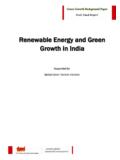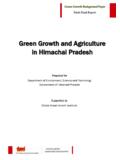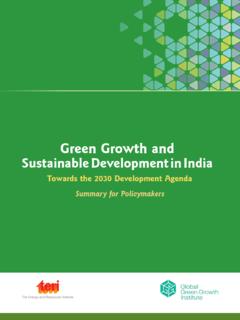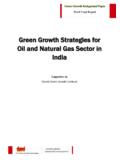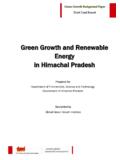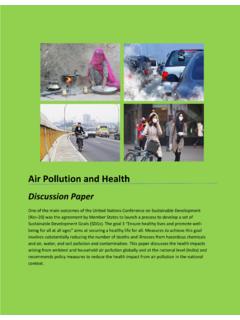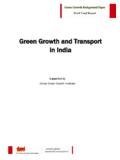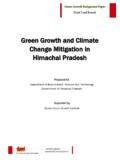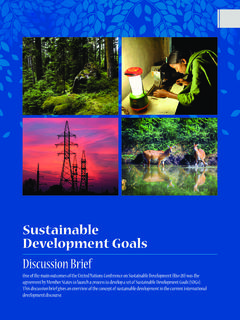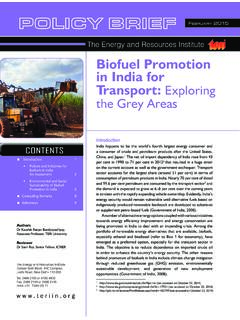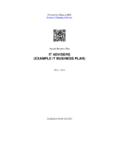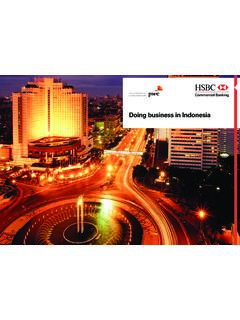Transcription of The Energy and Resources Institute CHALLENGES AND ...
1 The Energy and Resources InstituteIntroduction The plastic industry, owing to its use in a wide variety of sectors, such as the automotive, construction, electronics, healthcare, and textiles, is amongst the fastest growing markets. An analysis by Plastindia Foundation suggests that the industry has grown at a compound annual growth rate (CAGR) of 10%, in volume terms, from million metric tonne per annum (MMTPA) in FY 10 to MMTPA in FY 15 and is expected to grow at from FY 15 to FY 20 to reach 22 MMTPA. This growth would be further impelled by various government initiatives, such as Make in India, Skill India, Digital India, and the Swachh Bharat Figure 1 depicts the consumption of plastic in the various sectors. 1 2016. Indian Plastic Industry Set to Buck the Global Trend, Set to grow 12% This Year ; refer to ; last accessed on May 30, 2018. Plastic Waste Management in IndiaCHALLENGES AND OPPORTUNITIESCONTENTSI ntroduction 1 Problems Relating to Plastic Waste 4 Sustainable Plastic Waste Management Solutions 11 business /Technical Models for Plastic Waste Management 15 Conclusion 17 The Way Ahead 18 Authors: R R N Sailaja Bhattacharya , Kaushik Chandrasekhar, M V Deepthi, Pratik Roy, and Ameen Khan Reviewer: Dr Suneel Pandey Secretarial Support: Manjula K and Jyoti S2 While the petrochemical sector is regarded as the backbone of plastic production, it is also considered a yardstick for measuring global economic growth, wherein plastic processing and production is of vital Production of plastic (in terms of tonnage) is dominated by polyolefins, such as polyethylenes, polystyrene, and polypropylene.
2 The major polyolefin producers in India include the Reliance Industries, Indian Oil Corporation Limited, Haldia Petrochemicals, Bharat Petroleum Corporation Limited, and Gas Authority of India Limited. Figure 2 depicts the export figures for plastic to the various countries in FY 2015 It is expected that in the current financial year (FY 2 2018. Plastics Industry: Spurring Indians Economic Growth ; refer to ; last accessed on May 30, 2018. 3 The Indian Plastic Industry (October 2017); refer to ; last accessed on May 29, 2018. 2018), exports would cross 8 billion USD with an increased growth of in the first half of FY 2018 as compared to the past year. It is also envisaged that exports are expected to double in the next 5 years, owing to the growing domestic average per capita consumption of plastic in India is about 11 kg, which is considerably low as compared to the global average of 28 kg.
3 This is further brought into perspective with a special emphasis on the US where consumption is nearly ten times as has been shown in Figure 3. An estimate by the Ministry of Petroleum and Natural Gas, Government of India suggests that the annual per capita consumption in India would be 20 kg by 2022. Further, the World Economic Forum suggests that the volume of plastic production and consumption would considerably increase, thus leading to large amounts of plastic waste generation and related GHG emissions by 2050. Further, the forum also states that owing to the dependence on petroleum feedstocks, oil consumption will have increased threefold and the carbon budget would register an increase from 1% to 15%. Although the burgeoning rates of plastic production project positively for Indian businesses, the cause of concern is the lack of an organized mechanism to deal with 15,342 tonnes of plastic waste generated per day.
4 As per the Central Pollution Control Board (CPCB) reports, plastic contributes to 8% of the total solid waste, with Delhi producing the maximum quantity followed by Kolkata and Further, the report also suggests that 60% of the total 4 This is as per the CPCB- CIPET survey conducted for 60 Indian cities. 0200400600800 USChinaUAEUKG ermanyTurkeyItalyIranNepalBangladeshMill ion USDM illion USDFIGURE 2: Plastic exports in India FY 2015/16 Source: Ministry of Commerce and Industry, Government of India 1096538322811 USEuropeChinaBrazilGlobalaverageIndiaPer capita consump on(kg) 2014/15 FIGURE 3: Per capita consumption of plastics Source: FICCIFIGURE 1: Plastic consumption in various sectors Source: FICCIP ackagingInfrastructureAutoAgricultureIND IAWORLDO thersShare of plas c use in 2012/13 (%)4335211618151725283 DISCUSSION PAPER plastic waste is being recycled. The major challenge, however, is segregation and re-aggregation of plastic waste streams such as packaging waste, including laminated plastic.
5 Although recycling is one of the preferred ways to deal with plastic waste in the waste hierarchy, the concern is the heterogeneous properties of unsegregated and littered waste that remains scattered in the urban landscape. These result in an unpleasant landscape, choking of drains, and release of GHGs from landfills at times leading to fire. The major components of plastic waste (in terms of tonnage) have been expressed in Table 1: Major components of plastic waste with their applicationsPlasticApplicationPolyethyle ne terephthalate (PET)Water and soft drink bottles, food jarPolyvinyl chloride (PVC)Cables, plumbing pipesHigh-density polyethylene (HDPE) Shampoo bottles, packaging Low-density polyethylene (LDPE)Grocery bags, packaging Polypropylene (PP)Bottle caps, medicine bottles, chips packsPolystyrene (PS)Disposal cups, cutlery, packaging foamPolycarbonate (PC)Food packaging, electronic goods, and defence gadgetsNylonFishing nets, clothing, ropesThe research and policy fraternity is constantly exploring opportunities to address these problems.
6 Some existing options are: One of the sustainable alternatives that could be considered to deal with plastic waste is to develop bio-based and biodegradable plastic which utilize starch, cellulose, and poly lactic acid as raw materials for short-term use products. However, these are more expensive and are presently at a lab scale, which needs to be upscaled. Possible incentive-/subsidy-based strategies for product development and research would assist in facilitating this upscaling. This in turn would increase their usage and enhance the market for these products. Applications of bio-based products extend from the manufacturing of green packaging, disposable cutlery, agricultural mulch films, and manufacturing of superabsorbent materials, that can be used for a sustained release of pesticide/fertilizer in the agricultural sector. Further, these can also be used as eco-friendly alternatives for the removal of toxic dyes and heavy-metal contaminants from water bodies.
7 Recycling of plastics is considered the next viable and technically feasible option to tackle plastic waste. The approach utilizes several technologies to produce a second supply chain of raw materials. Recovery of secondary raw materials through recycling is given the highest priority after reuse, according to the waste hierarchy. Recycling options are generally classified into primary and secondary recycling, while tertiary recycling is preferred for multilayered plastics (MLPs) where separating individual layers is difficult and expensive. Recycling requires participation from the public and, therefore, needs citizens to perform separation of waste materials at the source. Another potential use of plastic is to generate fuel from waste plastics. The current Energy requirements are predominantly met using fossil fuels. Converting waste plastics to fuel is beneficial as it not only allows for waste plastic to be disposed of but also presents the opportunity of developing an alternative to fossil fuel.
8 However, this is still at the research stage. Studies reveal that presently, the methane number of pyrolysis gases is below 65 which is less than the minimum requirement as per the standard for the EU and USA. 5,6 Non-recyclable plastic waste finds its application in the co-processing of plastic waste in cement kilns. This refers to the use of wastes in industrial processes from which the Energy and material form is recovered. Plastic waste is also integrated with bitumen for laying roads. The process of laying roads by utilizing this technique has been well established for the advantages it paper seeks to explore and assess all aspects related to plastic waste management and the development of a sustainable alternative to plastics. It also touches upon laws and policy implementation. 5 Honus, S, Kumagai S, Molnar V Fedoko G, and Yoshioka T. 2018. Fuel 221: 361 Honus, S, Kumagai S Fedorko G, Molnary, and YoshiokaT.
9 2018. Fuel 221: 346 60. 4 Problems Relating to Plastic Waste Laws and their implementation In order to address the burgeoning rates of plastic waste disposal and to ensure its scientific management, Plastic Waste Management Rules (PWR), 2011, was introduced under the Environment Protection Act, 1986. The rules established a framework which assigned responsibilities for plastic waste management to the urban local body (ULB)7 and set-up a state-level monitoring committee. The rules further addressed the issue of carry bags by setting minimum standards for the thickness and a mandate for retailers to charge a fee for each plastic bag made available. The 2011 rules were succeeded by the Plastic Waste Management Rules 20168 which was far more comprehensive and sought to effectively address the issue of plastic waste. This version of the rules extended its purview and applicability to rural areas and plastic importers in the supply chain.
10 Further, the minimum thickness of plastic carry bags was increased from 40 micron to 50 micron. The rationale for doing this was double-edged that is, not only will the recyclability quotient increase, an increase in the manufacturing cost will deter retailers from supplying bags for free. The rules also mandated the producers and brand owners to devise a plan in consultation with the local bodies to introduce a collect back system. This system known as the Extended Producers Responsibility (EPR) would help assist the municipalities in tackling the plastic waste issue. As a part of the EPR, it also provides for collection of a fee from the producers, importers of plastic carry bags/multilayered packaging in order to strengthen the financial status of local authorities and, therefore, the plastic waste management 2016 rules were revised to be known as the Plastic Waste Management (Amendment) Rules 2018. Three major changes amongst others have been incorporated in the latter.
